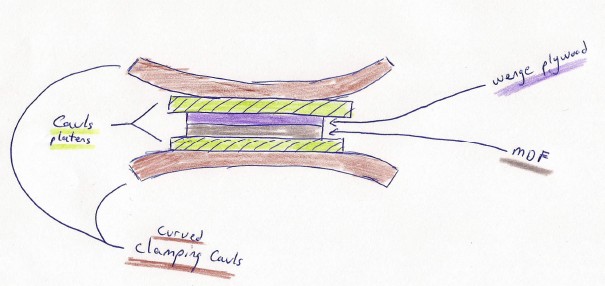Question
I currently have a sheet of 1/2" wenge veneer core left over from a job we did a couple of years ago. I have finally decided that I would like to attempt my first dining room table using this material. I would like to laminate the 1/2" plywood onto 3/4" MDF to thicken the top and then cut some leaves in. I've asked around and have received different answers. A friend who has experience in table making suggested this method mentioned above, while another colleague tells me that I would need to laminate the 1/2" to another material of the same proportion, meaning 1/2" plywood.
In your opinion, what would be the best way to tackle making the top thicker? Also, I do not have a vacuum press yet. I would be gluing this up with clamps and weights. I do it for small pieces all the time but have not had the opportunity to do this for something large. Can I get away with gluing this top without a press? Any suggestions would be greatly appreciated.
Forum Responses
(Furniture Making Forum)
From contributor D:
One method of achieving tremendous clamping pressure without a press is utilizing go sticks - used in traditional Japanese woodworking. Basically instead of using weights, you cut sticks or boards just slightly longer than the distance between your workbench or floor where your stock to be glued is, and the ceiling. You then jam them from a slight angle to nearly vertical. You should use a caul between your nice veneered ply and the sticks, to distribute the pressure evenly and to avoid damaging your ply. Trying to get anywhere near say, 100psi (still below recommended pressure) would be nearly impossible and pretty tiring moving weights around.
I know this sounds high. We'd purchased an old press years ago which used an air bladder and our compressed air for side pressure (about 110psi). We used it for about six months and I can say it caused us much heartache. Every expert we brought in, from glue industry or press industry, told us to quit using this machine (from the 1970's), as the pressure was not enough. It was great for edge gluing butcher block type glue upís, as the total area was not that high, but when we used it for veneering door stiles (an area normally 96" x 5"), it was not adequate. This was hard learned (and expensive) experience.
Yes a caul at the ceiling as well is a great idea. I never thought of it as I work in a concrete building. Honestly I have no idea how in the world a vacuum bag magically works at 14psi. I have stacked entire bundles of lumber (about 3000 lbs) with a forklift over veneered door stiles years ago to see gaps and bubbles later, so I do not trust weights for applying pressure.
There are lots of folks on here who use vacuum bags all the time that could weigh in. I only have 13 years in a professional environment, but I am challenged every day in a successful company. I feel pressures of 100psi are needed.
Start with a dry run to make sure everything will work and you have enough clamps. Apply glue to your sub straight; put some blue painters tape on the edges to keep the work piece from sliding around and place it between your platens. Then starting from the middle of the work apply the clamping cauls alternating either side.
I find it good to use MDF with Formica as the platens because glue doesnít adhere to it well and you can wipe it off with a damp rag or knock it off with a putty knife after itís dry. I would make a balanced sheet by gluing half inch ply to the other side as well and edge with solid stock. A nice thick top looks good on a dining table and adds to the heft which is important with plywood being so light.
